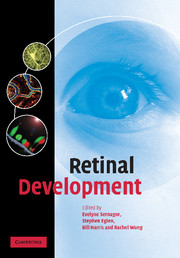Book contents
- Frontmatter
- Contents
- List of contributors
- Foreword
- Preface
- Acknowledgements
- 1 Introduction – from eye field to eyesight
- 2 Formation of the eye field
- 3 Retinal neurogenesis
- 4 Cell migration
- 5 Cell determination
- 6 Neurotransmitters and neurotrophins
- 7 Comparison of development of the primate fovea centralis with peripheral retina
- 8 Optic nerve formation
- 9 Glial cells in the developing retina
- 10 Retinal mosaics
- 11 Programmed cell death
- 12 Dendritic growth
- 13 Synaptogenesis and early neural activity
- 14 Emergence of light responses
- New perspectives
- 15 Regeneration: transdifferentiation and stem cells
- 16 Genomics
- 17 Zebrafish models of retinal development and disease
- Index
- Plate section
- References
15 - Regeneration: transdifferentiation and stem cells
Published online by Cambridge University Press: 22 August 2009
- Frontmatter
- Contents
- List of contributors
- Foreword
- Preface
- Acknowledgements
- 1 Introduction – from eye field to eyesight
- 2 Formation of the eye field
- 3 Retinal neurogenesis
- 4 Cell migration
- 5 Cell determination
- 6 Neurotransmitters and neurotrophins
- 7 Comparison of development of the primate fovea centralis with peripheral retina
- 8 Optic nerve formation
- 9 Glial cells in the developing retina
- 10 Retinal mosaics
- 11 Programmed cell death
- 12 Dendritic growth
- 13 Synaptogenesis and early neural activity
- 14 Emergence of light responses
- New perspectives
- 15 Regeneration: transdifferentiation and stem cells
- 16 Genomics
- 17 Zebrafish models of retinal development and disease
- Index
- Plate section
- References
Summary
Introduction
The study of regeneration in the vertebrate began with the pioneering experiments of Claude Bonnet in 1781. He found that if part of the eye of an adult newt (Triturus cristatus) was removed, a smaller, but complete, eye was regenerated within a few months. All of the ocular tissues, including the cornea, lens and retina, were capable of regenerating. Subsequent work by biologists, working primarily in the 1800s and early 1900s, characterized many critical features of the regeneration process in the eye. The molecular basis for this remarkable process is still not understood. However, recent progress in eye development research has spurred new lines of investigation into this question. In this review, we briefly discuss highlights of historical work and then focus on recent experiments in a variety of species that illustrates the complexities of the questions being investigated today.
A brief history of retinal regeneration
One of the first questions that arose historically concerning retinal regeneration in newts was the nature of the cells that provided the regenerated tissue. Early studies argued that a ring of cells at the peripheral retinal margin, what is now most commonly called the ciliary margin zone (CMZ), was the primary source of regenerated retina (Colucci, 1891 (cited in Keefe, 1973d); Fujita, 1913). Later studies confirmed the CMZ as a source of regeneration, but also demonstrated that the retinal pigmented epithelium (RPE) could regenerate neural retina in the posterior eye (Wachs, 1914, 1920).
- Type
- Chapter
- Information
- Retinal Development , pp. 307 - 324Publisher: Cambridge University PressPrint publication year: 2006



